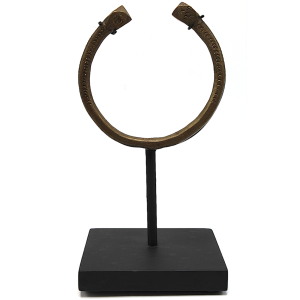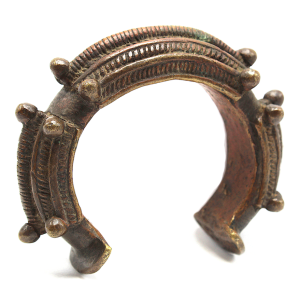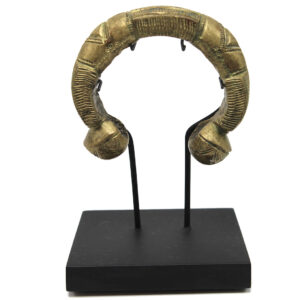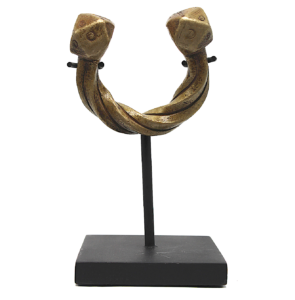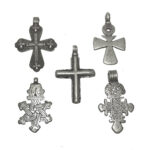Manillas: Former West African Trade Currency
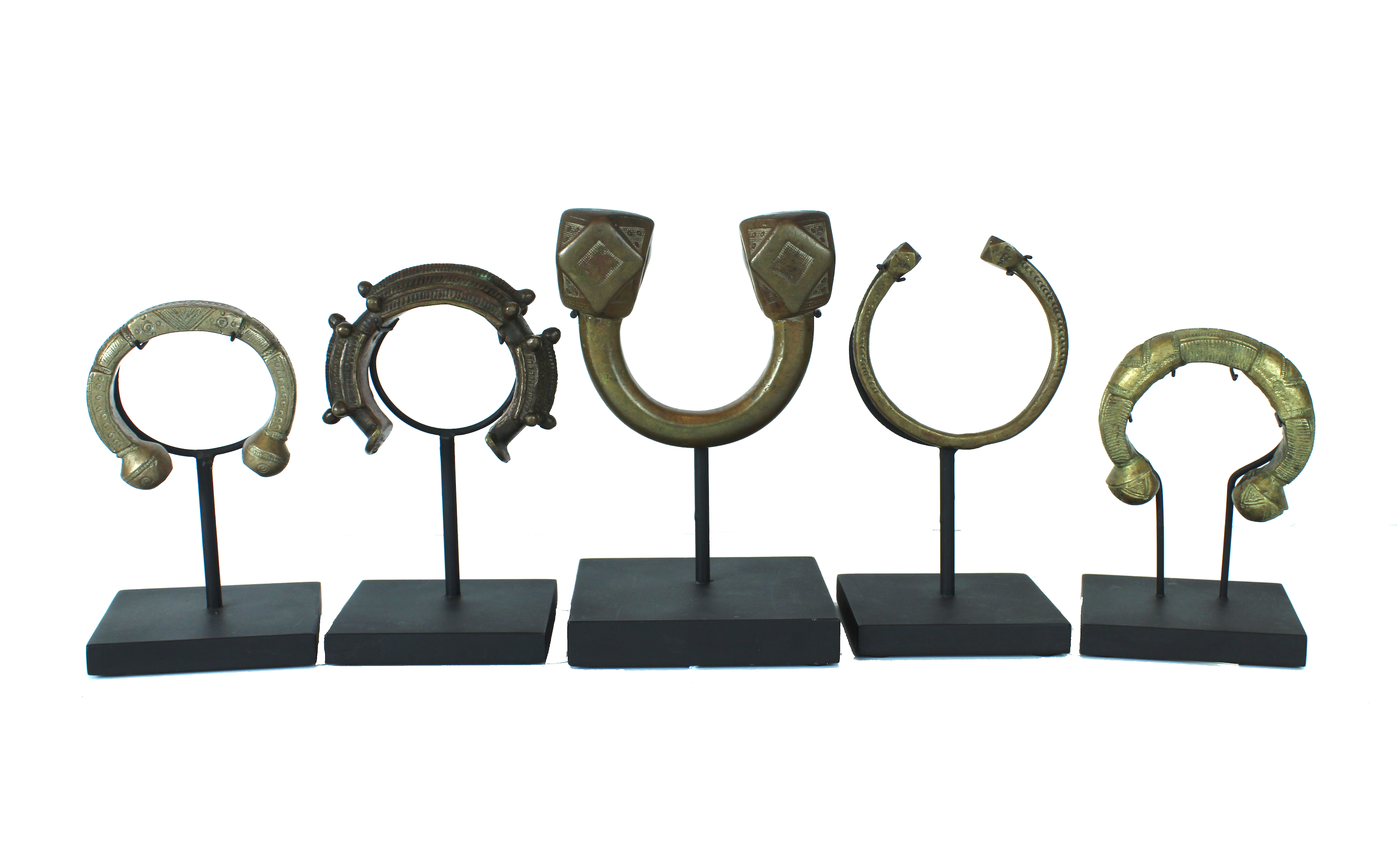
A manilla is an open metal bracelet given to newborns throughout Caribbean cultures where they are known mostly as a bangle. It is a treasured item that is essential for baby christenings or for a first birthday and worn until it is outgrown. Bangles are meaningful family treasures that are saved and passed on to offspring, and they are an item of prestige for Caribbean women of all races, an adored piece of fashion jewelry, and an article meant to store wealth, especially in the case of gold, silver, and highly valued antique pieces. Today, they adorn the wrists of West Indian, black, and women of all colors, as manillas are considered immensely popular pieces of jewelry both as a sign of social status and a reminder of the slave trade in their past.
Traditionally known as manillas, okpoho, okombo, or abi, metal bracelets were initially African-made and used as a form of currency by West African peoples. There is a debate as to when and where they first appeared, but West African coastal women wore open-ended bangles in the 15th century made mostly from copper and copper alloys. Often horseshoe-shaped with a ball on each end, they became symbols of their husband’s wealth and status. They were called the “red gold” of Africa due to their coloring, as copper was mined in Africa and traded early on by Arabs. Copper and copper alloy bracelets and leg-bands were a crucial trade currency and worn by women and as rich body ornamentation and to display their husbands’ prominence in the community. They were decorated with a rich variation of designs and motifs, and a mixture of sizes, shapes, weights, and styles were made and named using different words of regional origin. Manillas were prized for the sound they made when hit, and were used for many pre-colonial purposes: to trade or barter, to purchase land, livestock, or make other market purchases, to display status or social position, to pay for the expense of significant life events such as births, coming of age, marriages (i.e., as a bride price to compensate for the loss of a daughter), or burials, to pay diviners and for fines, as a way for nomadic people to travel with small amounts of portable wealth, and also as striking personal adornment. They were seen as common objects with an intrinsic and established monetary value and a respected medium of exchange throughout the African economic system where no banks or conventional economic systems existed.
Africans from each region fabricated their own varieties of manillas. They were typically horseshoe-shaped and most manillas were decorated with incised designs, and had added pieces of metal in various shapes to the body or at open ends. Other designs included deeply carved lines forming parallel ridges, stamped or incised geometric forms, and other motifs. They range in size from thin delicate shapes of the Tuareg Woman’s Fighting Bracelet to heavy massive construction of the Tuareg King and Queen Manillas. Bracelets might reveal personal information about the owner, although those motifs might only be understood in a local context. A particular design might contain a symbol indicating the village the owner was from or the woman wearing the manilla had a daughter. Bangles were also considered amulets containing considerable spiritual power, especially if they were made for a specific purpose following the advice of a medium or shaman, and were also said to prevent disease or accidents, bring wealth, increase fertility, or have other special powers. Most Africans agreed metals contain a vital life force called nyama, an animating natural force present in everything.
Bracelets were the most common metal trade objects and were well suited for their important monetary function of acceptability as a standard of value because of their small size and easy portability. Their popularity was greatly enhanced because they were perfectly suitable not only as a display of wealth but also as attractive body ornamentation, both of which appealed to West Africans. Bangle variants of all kinds were well accepted throughout Africa, and were universally recognized as trade currency. It is extremely difficult to ascertain with certainty the origin of many pieces since many tribal peoples making them were nomadic traders throughout many regions, large tribal groups and sub-groups existed in multiple regions, and designs were often reused and they were widely circulated throughout West Africa. Although bracelets were the main form of West African trade currency, other lesser forms of trade and payments included textiles, ivory, and other metal items including spears, necklaces, throwing knives, tools, and gourds covered over brass rings. Cowrie shells, imported from Melanesia and valued at a small fraction of a manilla, were used for small purchases
Despite regional variations, African metallurgists no longer make manillas, but they continue to make other metal objects in secret and away from the community, practice complex rituals that include prayers and songs designed to achieve success in production, and use potions and sacrifices to ward off evil spirits and prevent pollution by malevolent forces. African metallurgy is also a mystical and quasi-religious process that is likened to sexual reproduction. Its practices are compared to conception and birth, fabrications are done only by men, and the practice remains surrounded by strict taboos. Furnaces are often decorated to resemble a woman, yet if a woman touches any materials, the entire procedure is considered threatened and a new round of purifications and rituals must be performed.
In the 1470s recognizing the importance of copper bracelets and leg bands as displays of wealth and as currency in West African, Portuguese merchants advised the Portuguese Crown to fabricate slave currency in Antwerp. They created wearable crescent rings with flared ends which they named “manillas” derived from Spanish, Latin, and Portuguese words for bracelet, hand, and necklace. Once an indigenous form of currency for West African peoples, manillas became the main currency for the slave trade to the Americas. By the end of the 1500s, British, French, and Dutch colonial powers manufactured manillas in large quantities to trade for slaves working in plantations in the West Indies and by the early 1700s Britain was the largest brass manillas producer used by both European slave traders and American traders for southern cotton plantations.
A circular Atlantic slave trade route developed whereby manillas were manufactured in Europe, exported by ship to West Africa to buy slaves, then shipping and selling slave survivors in the New World, and returning to Europe to pick up another shipload of manillas. This was a very profitable business, as Europeans co-opted African metallurgy techniques and design motifs to mass-produce bracelets from iron, brass, bronze, and mixed alloys in European factories. Items were only rarely made locally of silver and gold for very affluent Africans, and they were valued differently in each region. They soon became known as “slave bracelets,” “slave trade money,” “bracelet money,” and other local variations. They rapidly became the prime African medium of exchange and the most common measure and store of intrinsic value throughout Africa. Slaves were valued by numbers and sizes of manillas. In Nigeria in 1505 for example, a slave was priced at 8-10 manillas.
Manilla production decreased in the 19th century as the slave trade diminished in Europe and later the United States. Although slavery in British colonies was abolished in 1833, use of bracelets as a legal trade currency was not terminated until 1911 and was prohibited for use by foreign traders under the Manilla Currency Ordinance of 1919. However, they continued to be used along with the new money created by the West African Currency Board for several decades. During the 1940s and 50’s, there was a strong and successful movement to collect, confiscate, and melt down African manillas to use for other purposes. The bracelets were finally abolished after WWII but functioned as a medium of exchange in British West Africa until April 1, 1949.
Manillas are still worn by slave descendants in the Caribbean and kept as a significant family treasure to be passed on to future generations. They are also extremely popular with West Indian Caribbean women and considered a preferred and fashionable piece of jewelry worn as a status symbol. While many Caribbean people are aware that these bangles are somehow linked to slavery and the slave trade, they are often unaware of the history and circumstances surrounding their use. It is fascinating that the prevalence and usage today are for those made from precious metals and that they still hold their value and original purpose of being a symbol of wealth and social status. Although many believe that manillas remain traditional and customary fashion accessories and preserve and honor their culture and history, others may see them as a reminder of a disastrous part of African history where Africans sold each other for pieces of metal. Either way, they remain fascinating, important, and impressive historical and cultural items.
Some of the collectible manillas are from the Senufo Peoples on the Ivory Coast, the Tuareg from Mali the Fulani from Nigeria, Ghana and Burkina Faso, and the Yoruba from Niger.
Sources:
- Etsey Atisu,” Manilla: the money used during the slave trade in West Africa,” Face2Face Africa, June 27, 2019.
- Eric Edwards, “Rethinking Pitt-Rivers, Manilla or penannular bracelet currency,”
- Hamill Gallery, “Manilla Currency, West Africa”
- Manchester Museum, University of Manchester, Africa, “The arrival of European and the transatlantic slave trade,” Revealing Histories Remembering Slavery
- Orijinculture.com, “Untold story behind Bangles (Manillas) – A “Slave Trade Money” to the Must Have Jewelry.”
- Past & Present, the Stamp and Coin Place Blog, “Manilla: The Former Currency of West Africa,” September 18, 2018
- us slave blogspost, “Manilla: Money of the Slave Trade,” October 2011.
“

